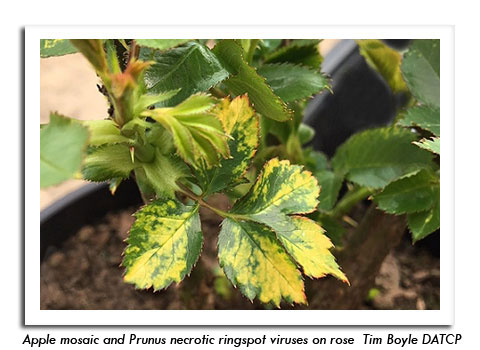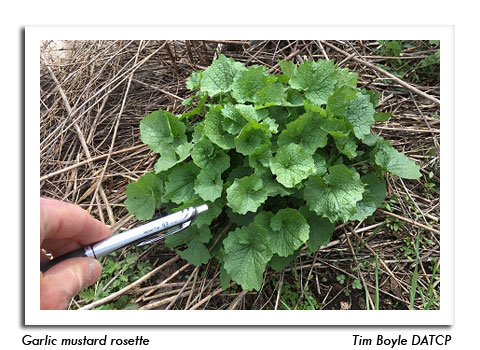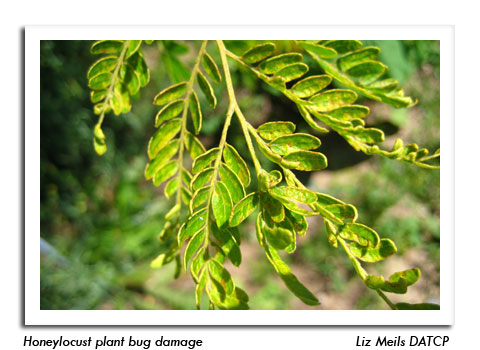
 |
|
|
Nursery & Forest
Volume 62 Number 1 Date 04/27/2017 ROSE VIRUSES - Rose plants testing positive for apple mosaic virus and Prunus necrotic ringspot virus arrived in Wisconsin last month in a shipment originating in Arizona. The roses harbored both viruses on the same individual plants, which exhibited characteristic yellow chlorotic mottling on the dark green leaves. Necrotic and chlorotic local lesions, mosaic patterns, and ringspots are also typical with these diseases. Both types of viruses can be transmitted by mechanical inoculation and through grafting. Virus-infected roses are less vigorous, more susceptible to winter mortality, and should be removed from sale and destroyed or returned to the supplier. GARLIC MUSTARD AND WILD PARSNIP - Emergence and rosette development of these invasive plants has been noted as far north as Chippewa County. Efforts to remove or treat these weeds will be most effective against the first-year rosette stage plants. Garlic mustard can be controlled by manual removal, and wild parsnip by cutting the taproot just below the soil surface. Removed plants should be placed in dark plastic bags and disposed of in a landfill. For extensive infestations where herbicide use is required, application of 2, 4-D and/or Dicamba to the plants in very early spring or fall also provides control. -- Tim Boyle, DATCP Nursery Inspector HEMLOCK WOOLY ADELGID - Nursery stock dealers and growers are reminded that DATCP has enacted an exterior quarantine (ATCP 21.16) regulating the entry of hemlock plant material from states infested with hemlock wooly adelgid (HWA). This aphid-like insect has caused widespread mortality of eastern and Carolina hemlock trees from Maine to Georgia and now occurs in 19 states, including neighboring Michigan where there are 14 known active populations in five southwestern counties. Eradication of HWA may be possible if an infestation is detected early, but preventing introduction of HWA into the state is preferred. Nursery operators should closely inspect hemlock trees purchased from an out-of-state nursery and report any suspicious hemlocks to a DATCP Nursery Inspector. OAK WILT - Abnormal warmth in February and March was very favorable for early growth of fungal mats and activity by the insect vectors of oak wilt. It is strongly recommended that Wisconsin residents do not trim or prune oak trees from now through the end of October. The lethal fungus that causes oak wilt enters oak trees through new wounds, making late-spring or summer pruning an unnecessary risk. The preferred time to prune oaks is from October through March. If oaks must be trimmed or cut during the growing season, the wound should immediately be treated with pruning paint to prevent infection. HONEY LOCUST PLANT BUG - Nymphs are emerging statewide and are feeding on expanding honey locust foliage. Light feeding by the HLPB in spring causes yellow stippling of the leaves, while severely infested trees develop tattered foliage which persists all summer. Most of the feeding damage caused by this pest occurs before the leaves have fully developed, so early treatment is critical. Nymphs can be controlled chemically with horticultural oil or insecticidal soap, or physically, with a high-pressure sprayer. Honey locust cultivars with yellow leaves are generally more susceptible to plant bugs than varieties with green leaves. -- Timothy Allen, DATCP Nursery Inspector GYPSY MOTH - Approximately 11,000 pheromone traps will be set in the western half of the state this season to evaluate gypsy moth populations. Trap deployment is scheduled to begin during the week of May 8 and should be complete by early July. Landowner cooperation in allowing traps to be set on their property is imperative to the success of the annual trapping survey. -- Chris Whitney, DATCP Gypsy Moth Trapping Coordinator PLANT DISEASE DIAGNOSTICS CLINIC - The UW-Madison/Extension Plant Disease Diagnostics Clinic provides unbiased, research-based plant disease identification and control recommendations for Wisconsin agricultural/horticultural producers and businesses, and homeowners. Plant samples may be submitted through a county UW-Extension office or directly to the clinic. Fees for PDDC services are typically $20-25, although additional charges may apply depending on the sample type and tests requested. Some tests are free. PDDC tests include, but are not limited to, those for soybean cyst nematode [including race typing in partnership with the UW Nematode Diagnostic Lab], tar spot and Goss' wilt of corn, Aphanomyces seedling blight/root rot (including race testing of soil) of alfalfa, late blight of potato and tomato, black leg/tuber soft rot (Dickeya) of potato, downy mildew and virus diseases of hop, thousand canker disease of walnut, boxwood blight, and impatiens downy mildew. Questions about submitting a sample or PDDC fees should be directed to PDDC Director Brian Hudelson at (608) 262-2863 or pddc@wisc.edu. -- Brian Hudelson, PPDC Director 




|
|
|